

|
|
Δείτε εδώ τα πιο πρόσφατα μηνύματα από όλες τις περιοχές συζητήσεων, καθώς και όλες τις υπηρεσίες της AcroBase. H εγγραφή σας είναι γρήγορη και εύκολη. |
|
|||||||
|
 |
|
|
Εργαλεία Θεμάτων | Τρόποι εμφάνισης |
 |
#151
|
 |
 |
#152
|
 |
|
||||
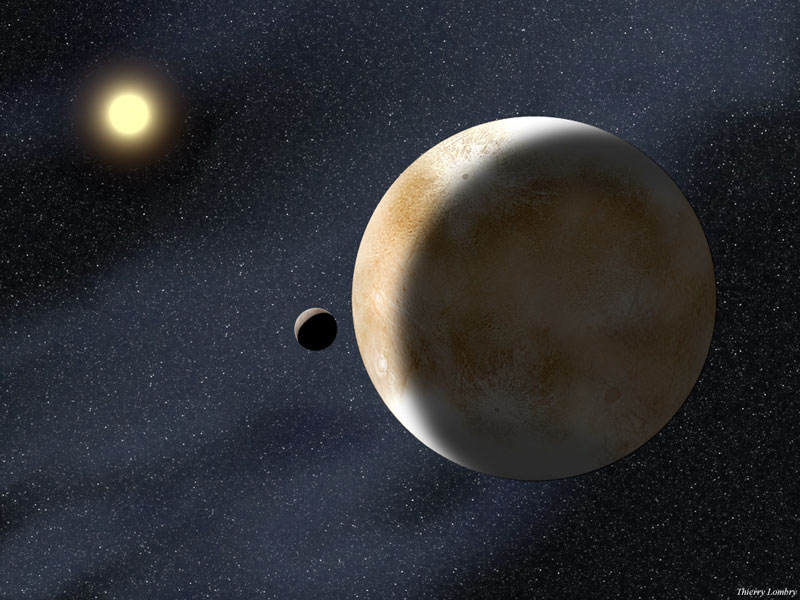 Eris: More Massive than Pluto Credit & Copyright: Thierry Lombry Explanation: Eris, a dwarf planet currently orbiting the Sun at about twice Pluto's distance, has been measured to have about 27 percent more mass than Pluto. The mass was calculated by timing the orbit of Eris' moon Dysnomia. Images taken with a ground-based Keck telescope, when combined with existing images taken by Hubble Space Telescope, show that Dysnomia has a nearly circular orbit lasting about 16 days. Cataloged as 2003 UB313 only a year ago, infrared images also showed previously that Eris is actually larger in diameter than Pluto. The plane of Eris' orbit is well out of the plane of the Solar System's planets. In the above drawing, a scientific artist has imagined Eris and Dysnomia orbiting our distant Sun. No space missions are currently planned to Eris, although the robotic New Horizons spacecraft bound for Pluto has recently passed Jupiter. Tomorrow's picture: open space Πηγη
__________________
όταν γράφεται η ιστορία της ζωής σου, μην αφήνεις κανέναν να κρατάει την πένα |
 |
#153
|
 |
|
||||
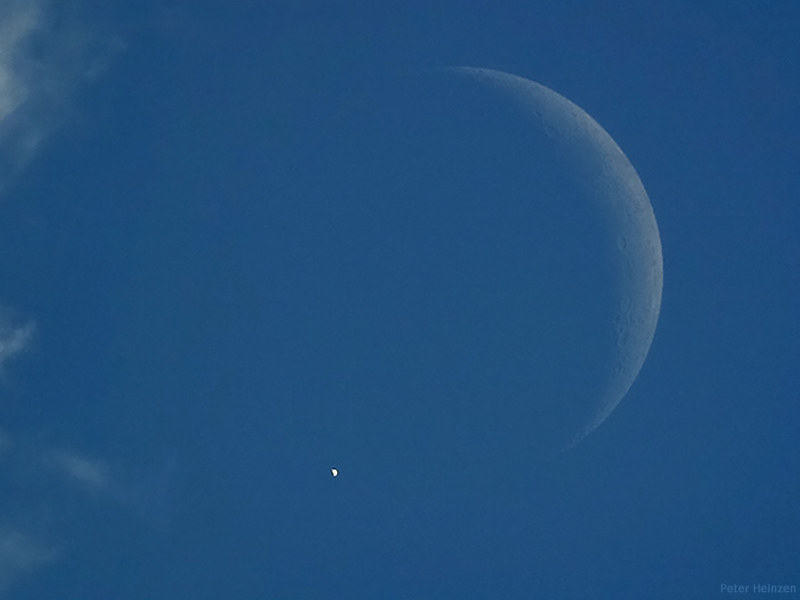 A Daylight Eclipse of Venus Credit & Copyright: Peter Heinzen Explanation: Something was about to happen. Just two days ago, two of the three celestial objects easily visible during the day appeared to collide. But actually, Earth's Moon passed well in front of the distant planet Venus. The occultation was caught from Switzerland in the hours before sunset. Moments after this image was taken, the Moon, visible as the crescent on the right of the above image, eclipsed Venus, appearing in gibbous phase on the lower left. Clouds that once threatened to obscure the whole event, were visible on the far left. About 90 minutes later, Venus re-appeared just to the right of the bright crescent. Tomorrow's picture: solstice sun Πηγή
__________________
όταν γράφεται η ιστορία της ζωής σου, μην αφήνεις κανέναν να κρατάει την πένα |
 |
#154
|
 |
|
||||
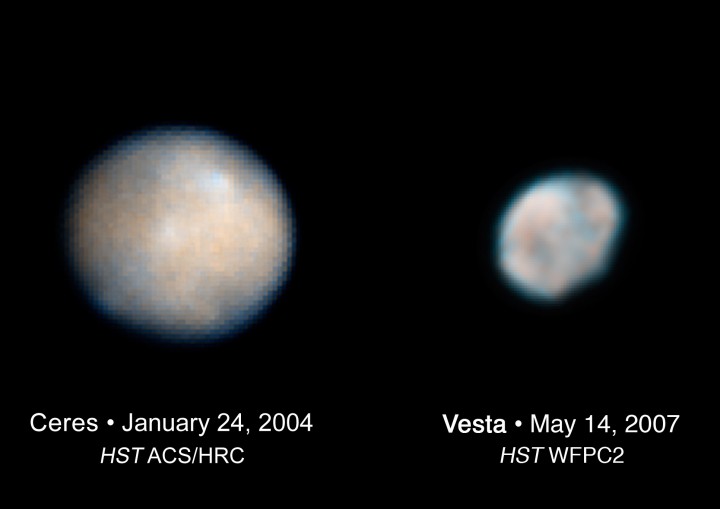 Small Worlds Ceres and Vesta Credit : NASA, ESA, L.McFadden, J.Y.Li (UMCP), M.Mutchler, Z.Levay (STScI), P.Thomas (Cornell), J.Parker, E.Young (SwRI), C.Russell, B.Schmidt (UCLA) Explanation: Ceres and Vesta are, respectively, only around 950 kilometers and 530 kilometers in diameter - about the size of Texas and Arizona. But they are two of the largest of over 100,000 minor bodies orbiting in the main asteroid belt between Mars and Jupiter. These remarkably detailed Hubble Space Telescope images show brightness and color variations across the surface of the two small worlds. The variations could represent large scale surface features or areas of different compositon. The Hubble image data will help astronomers plan for a visit by the asteroid-hopping Dawn spacecraft, scheduled for launch on July 7 and intended to orbit first Vesta and then Ceres after a four year interplanetary cruise. Though Shakespeare might not have been impressed, nomenclature introduced by the International Astronomical Union in 2006 classifies nearly spherical Ceres as a dwarf planet. Tomorrow's picture: Stereo Saturday Πηγή
__________________
όταν γράφεται η ιστορία της ζωής σου, μην αφήνεις κανέναν να κρατάει την πένα |
 |
#155
|
 |
|
||||
 Κάντε κλικ για να την δείτε σε μεγάλη ανάλυση. Σήμερα θα ήθελα να δείτε σε σοβαρή ανάλυση το Atlantis την ώρα που οι ρόδες του πατάνε τον διάδρομο της Στρατιωτικής βάσης Edwards. Προσέξτε στο πίσω μέρος την εκτόξευση του αλεξιπτώτου.  Σε λίγες μέρες το Atlantis θα μεταφερθεί στην ράχη ενός 747, στην έδρα του στο Διαστημικό κέντρο Κένεντυ. (Φωτ. αρχείου)
__________________
όταν γράφεται η ιστορία της ζωής σου, μην αφήνεις κανέναν να κρατάει την πένα |
 |
#156
|
 |
|
||||
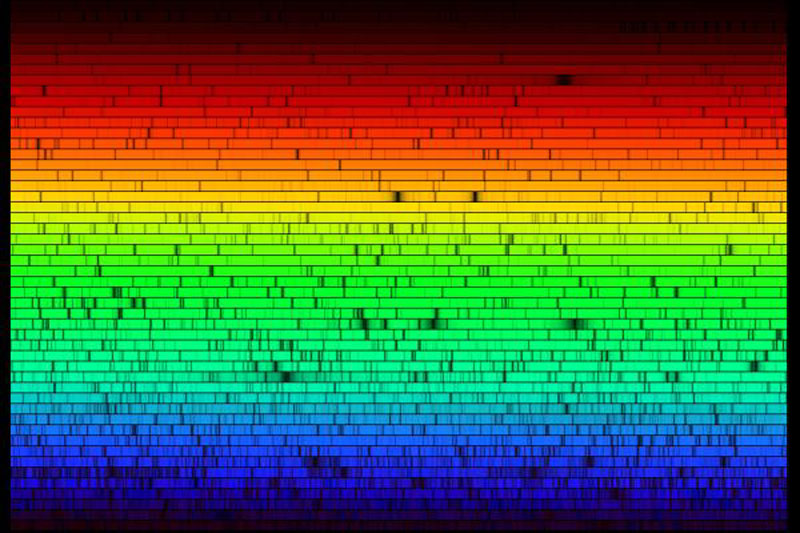 All the Colors of the Sun Credit & Copyright: Nigel Sharp (NSF), FTS, NSO, KPNO, AURA, NSF Explanation: It is still not known why the Sun's light is missing some colors. Shown above are all the visible colors of the Sun, produced by passing the Sun's light through a prism-like device. The above spectrum was created at the McMath-Pierce Solar Observatory and shows, first off, that although our yellow-appearing Sun emits light of nearly every color, it does indeed appear brightest in yellow-green light. The dark patches in the above spectrum arise from gas at or above the Sun's surface absorbing sunlight emitted below. Since different types of gas absorb different colors of light, it is possible to determine what gasses compose the Sun. Helium, for example, was first discovered in 1870 on a solar spectrum and only later found here on Earth. Today, the majority of spectral absorption lines have been identified - but not all. Tomorrow's picture: man made moon Πηγή
__________________
όταν γράφεται η ιστορία της ζωής σου, μην αφήνεις κανέναν να κρατάει την πένα |
 |
#157
|
 |
|
||||
 Κάντε κλίκ για να θαυμάστε τον Διαστημικό Σταθμό σε μεγάλη ανάλυση The International Space Station Expands Again Credit: STS-117 Shuttle Crew, NASA Explanation: The developing International Space Station (ISS) has changed its appearance again. During the past week, the Space Shuttle Atlantis visited the ISS and added pieces of the Integrated Truss Structure that mirrored those added in September 2006, including a second impressively long array of solar panels. The entire array of expansive solar panels are visible at the edges of the above image taken by the Shuttle Atlantis Crew after leaving the ISS to return to Earth. The world's foremost space outpost can be seen developing over the past several years by comparing the above image to past images. Also visible above are many different types of modules, a robotic arm, another impressive set of solar panels, and a supply ship. Construction began on the ISS in 1998. Tomorrow's picture: dusty starscape glowing Πηγή
__________________
όταν γράφεται η ιστορία της ζωής σου, μην αφήνεις κανέναν να κρατάει την πένα |
 |
#158
|
 |
|
||||
 Wisps of the Iris Nebula Credit & Copyright: Thomas V. Davis (tvdavisastropix.com) Explanation: Like delicate cosmic petals, these clouds of interstellar dust and gas have blossomed 1,300 light-years away in the fertile star fields of the constellation Cepheus. Sometimes called the Iris Nebula and dutifully cataloged as NGC 7023, this is not the only nebula in the sky to evoke the imagery of flowers. Still, this beautiful digital image shows off the Iris Nebula's range of colors and symmetries in impressive detail. Within the Iris, dusty nebular material surrounds a massive, hot, young star in its formative years. Central filaments of cosmic dust glow with a reddish photoluminescence as some dust grains effectively convert the star's invisible ultraviolet radiation to visible red light. Yet the dominant color of the central nebula is blue, characteristic of dust grains reflecting starlight. Dark, obscuring clouds of dust and cold molecular gas are present on the left of the image, and lead the eye to see other convoluted and fantastic shapes. Infrared observations indicate that this nebula may contain complex carbon molecules known as PAHs. As shown here, the bright blue portion of the Iris Nebula is about six light-years across. Tomorrow's picture: open space Πηγή
__________________
όταν γράφεται η ιστορία της ζωής σου, μην αφήνεις κανέναν να κρατάει την πένα |
 |
#159
|
 |
|
||||
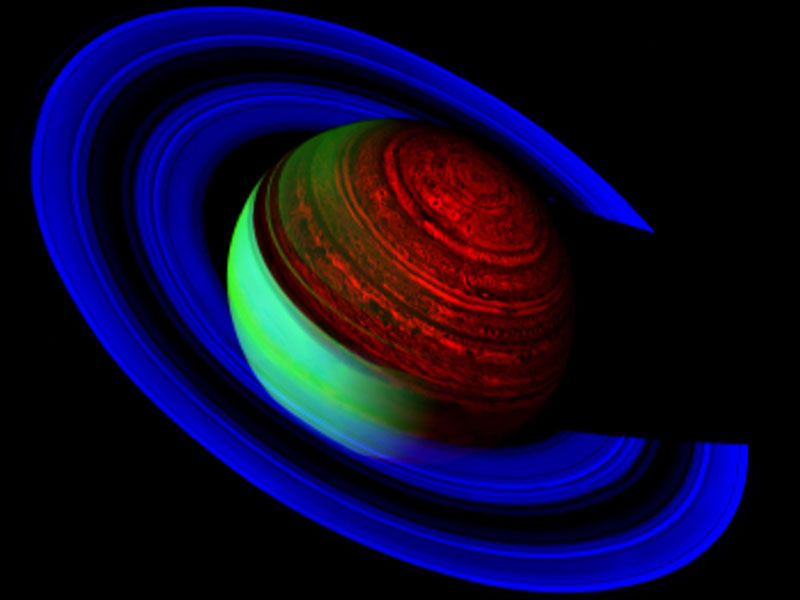 Neon Saturn Credit: VIMS Team, U. Arizona, ESA, NASA Explanation: If seen in the right light, Saturn glows like a neon sign. Although Saturn has comparatively little of the element neon, a composite image false-colored in three bands of infrared light highlights features of the giant ringed planet like a glowing sign. At the most blue band of the infrared light featured, false-colored blue in the above image, Saturn itself appears dark but Saturn's thin rings brightly reflect light from our Sun. Conversely, Saturn's B ring is so thick that little reflected light makes it through, creating a dark band between Saturn's A and C rings. At the most red band of the infrared, false-colored red above, Saturn emits a surprisingly detailed thermal glow, indicating planet-wide bands, huge hurricane-like storms, and a strange hexagon-shaped cloud system around the North Pole. In the middle infrared band, false-colored green, the sunlit side of Saturn's atmosphere reflects brightly. The above image was obtained in late February by the robotic Cassini spacecraft orbiting about 1.6 million kilometers out from Saturn. Tomorrow's picture: open space Πηγή
__________________
όταν γράφεται η ιστορία της ζωής σου, μην αφήνεις κανέναν να κρατάει την πένα |
 |
#160
|
 |
|
||||
 A Vist from Atlantis Credit & Copyright: Ron Dantowitz, Marek Kozubal, Clay Center Observatory Dexter and Southfield Schools Explanation: This remarkable image of the space shuttle orbiter Atlantis docked with the International Space Station (ISS) was taken at a range of 190 nautical miles. To record the fast moving pair, last week astronomers at Clay Center Observatory, near Boston, Massachusetts, planet Earth, used a satellite tracking system and 25-inch diameter telescope in combination with a digital video camera. In the sharp picture, Atlantis is below and left of center. The aft view shows three main engines just below its vertical tail glinting in the sunlight. With the Sun shining from below, the body of the orbiter casts a long shadow across the ISS itself and impressive details of the ISS solar arrays used for power generation are easily visible. The large set of solar arrays installed at the lower right was delivered during this visit from Atlantis. Tomorrow's picture: beyond the eye Πηγή
__________________
όταν γράφεται η ιστορία της ζωής σου, μην αφήνεις κανέναν να κρατάει την πένα |
 |
#161
|
 |
|
||||
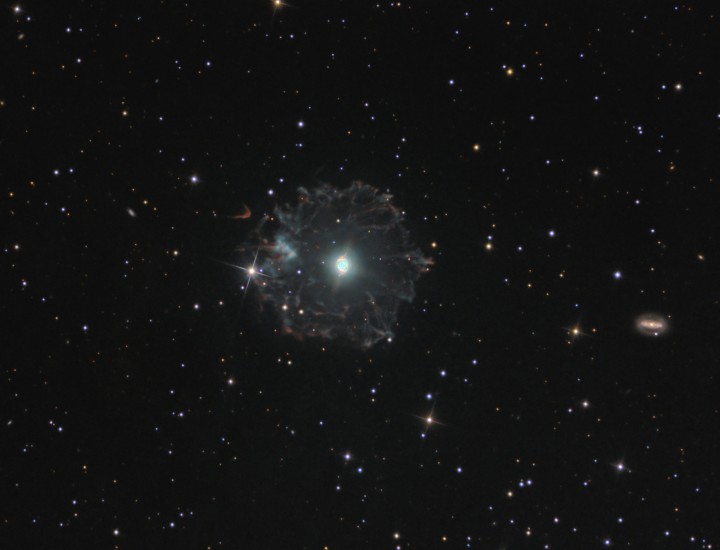 Κάντε κλικ για μεγέθυνση Cat's Eye Wide and Deep Credit & Copyright: Johannes Schedler (Panther Observatory) Explanation: The Cat's Eye Nebula (NGC 6543) is one of the best known planetary nebulae in the sky. Its more familiar outlines are seen in the the brighter central region of this impressive wide-angle view. But the composite image also combines many short and long exposures to reveal the nebula's extremely faint halo. At an estimated distance of 3,000 light-years, the faint outer halo is over 5 light-years across. Planetary nebulae have long been appreciated as a final phase in the life of a sun-like star. More recently, some planetary nebulae are found to have halos like this one, likely formed of material shrugged off during earlier episodes in the star's evolution. While the planetary nebula phase is thought to last for around 10,000 years, astronomers estimate the age of the outer filamentary portions of this halo to be 50,000 to 90,000 years. Visible on the right, some 50 million light-years beyond the Cat's Eye, lies spiral galaxy NGC 6552. Tomorrow's picture: light-weekend Πηγή
__________________
όταν γράφεται η ιστορία της ζωής σου, μην αφήνεις κανέναν να κρατάει την πένα |
 |
#162
|
 |
|
||||
|
Η διαστημική φωτογραφία της ημέρας
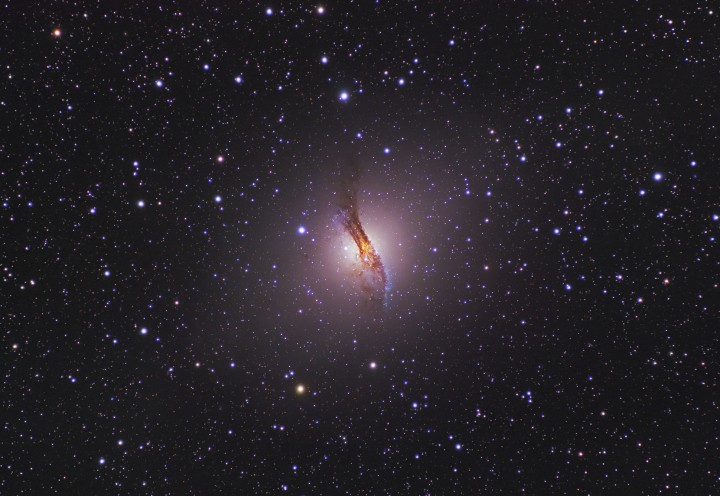 Κλικ για μεγέθυνση Jumbled Galaxy Centaurus A Credit & Copyright: Robert Gendler and Stephane Guisard Explanation: At the center of this sharp skyscape, Centaurus A seems to be a fantastic jumble of old yellow stars, young blue star clusters, and imposing dark dust lanes. Spanning over 60,000 light-years, the peculiar elliptical galaxy is apparently the result of a collision of two otherwise normal galaxies. The left over cosmic debris is steadily being consumed by a black hole with a billion times the mass of the Sun which lies at the center of Centaurus A. It's likely that such black hole central engines generate the radio, X-ray, and gamma-ray energy radiated by Centaurus A and other active galaxies. For an active galaxy Centaurus A is close, a mere 10 million light-years away, and is well-studied by earthbound astronomers. Check out: Venus and Saturn in tonight's evening sky. Tomorrow's picture: good climbing Πηγή
__________________
όταν γράφεται η ιστορία της ζωής σου, μην αφήνεις κανέναν να κρατάει την πένα |
 |
#163
|
 |
|
||||
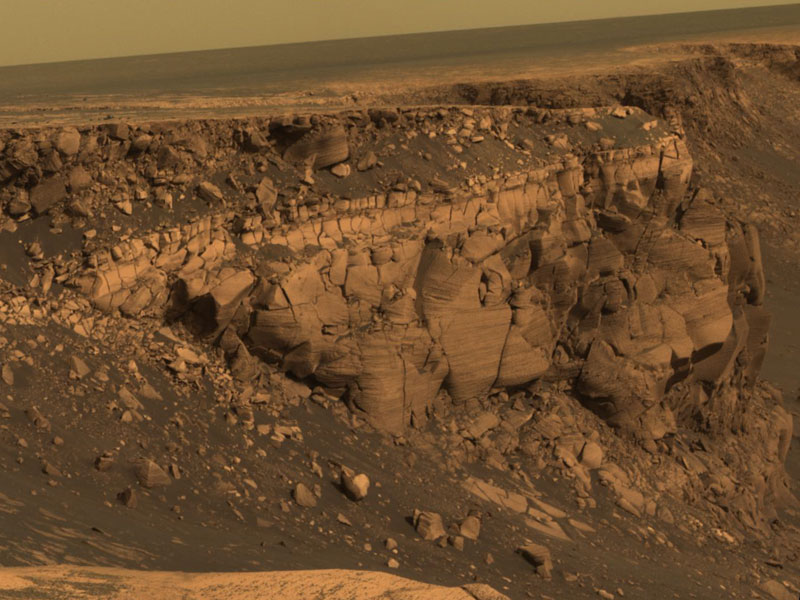 At the Edge of Victoria Crater Credit: Mars Exploration Rover Mission, Cornell, JPL, NASA Explanation: We're going in. The robotic Opportunity rover currently rolling across Mars has been prowling around the edge of the largest crater it has visited since landing over three years ago. It has been studying Victoria crater and looking for a way in. Now scientists on Earth have decided to take a calculated risk and plan to send Opportunity right into this ancient Martian crater over the next few weeks. Pictured is Cape St. Vincent, part of the wall of Victoria Crater next to where Opportunity will descend. The wall itself appears to contain clues about the Martian terrain before the impact that created Victoria crater, and so will be studied during the daring descent. Above the crater wall, far in the distance, lays a relatively featureless Martian horizon. Tomorrow's picture: skylights Πηγή
__________________
όταν γράφεται η ιστορία της ζωής σου, μην αφήνεις κανέναν να κρατάει την πένα |
 |
#164
|
 |
|
||||
 Red, White, and Blue Sky Credit & Copyright: Chris Schur Explanation: Contrasting colors in this beautiful sunset sky were captured on June 30 from Clear Creek Canyon Observatory in central Arizona, USA. The twilight scene includes brilliant Venus as the evening star, with a bright Saturn just above it, shining through thin clouds. The two wandering planets were a mere 1 degree apart or so, about twice the width of the full Moon rising above the eastern horizon on the other side of the sky. In fact, such serene skyviews were possible from all over planet Earth as Venus and Saturn approached a conjunction. Regulus, alpha star of the constellation Leo, is above and to the left of the close planetary pairing. At dusk, lights in tonight's sky will also feature Venus and Saturn low in the west and separated by about 2 degrees. Tomorrow's picture: night-shining clouds Πηγή
__________________
όταν γράφεται η ιστορία της ζωής σου, μην αφήνεις κανέναν να κρατάει την πένα |
 |
#165
|
 |
|
||||
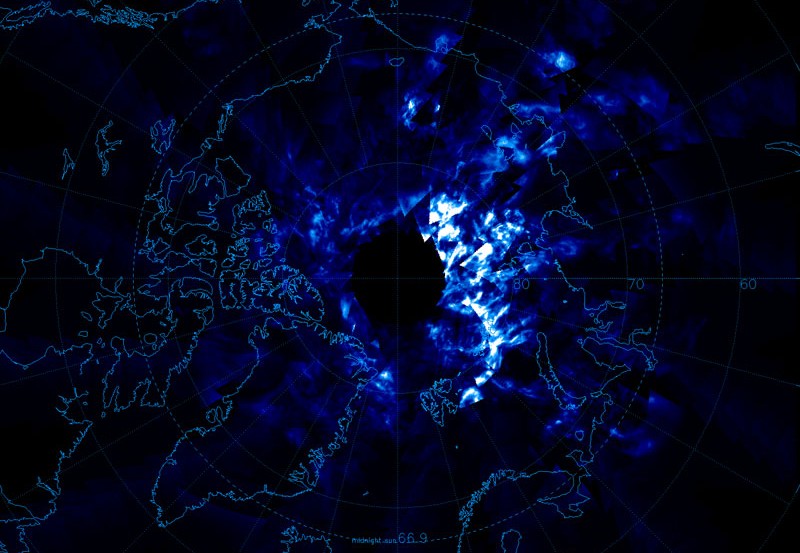 Night-Shining Clouds Credit: Cloud Imaging Team (LASP, Univ. Colorado), AIM project, NASA Explanation: Alluring noctilucent or night-shining clouds lie near the edge of space, some 80 kilometers above Earth's surface. Of course, when viewed from space the clouds are more properly called polar mesospheric clouds (PMCs) -- seen here for the first time in image data from the Aeronomy of Ice in the Mesosphere (AIM) satellite. The clouds form over the poles in the corresponding summer season and are now being seen more frequently at lower latitudes. This paticular view from June 11 details the PMC structures forming over the north polar region in white and blue. (Black indicates no cloud data was available.) The AIM satellite should be able to track two complete cloud seasons over both poles to investigate possible connections between the high altitude night-shining clouds and global change in the lower atmosphere. Tomorrow's picture: pixels in space Πηγή
__________________
όταν γράφεται η ιστορία της ζωής σου, μην αφήνεις κανέναν να κρατάει την πένα |
 |
| Συνδεδεμένοι χρήστες που διαβάζουν αυτό το θέμα: 4 (0 μέλη και 4 επισκέπτες) | |
|
|